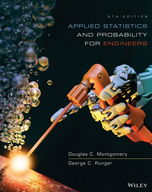Solution Found!
Solved: In the manufacture of electroluminescent lamps,
Chapter 5, Problem 67E(choose chapter or problem)
Problem 67E
In the manufacture of electroluminescent lamps, several different layers of ink are deposited onto a plastic substrate. The thickness of these layers is critical if specifications regarding the final color and intensity of light are to be met. Let X and Y denote the thickness of two different layers of ink. It is known that X is normally distributed with a mean of 0.1 mm and a standard deviation of 0.00031 mm, and Y is also normally distributed with a mean of 0.23 mm and a standard deviation of 0.00017 mm. Assume that these variables are independent.
(a) If a particular lamp is made up of these two inks only, what is the probability that the total ink thickness is less than 0.2337 mm?
(b) A lamp with a total ink thickness exceeding 0.2405 mm lacks the uniformity of color that the customer demands. Find the probability that a randomly selected lamp fails to meet customer specifications.
Questions & Answers
QUESTION:
Problem 67E
In the manufacture of electroluminescent lamps, several different layers of ink are deposited onto a plastic substrate. The thickness of these layers is critical if specifications regarding the final color and intensity of light are to be met. Let X and Y denote the thickness of two different layers of ink. It is known that X is normally distributed with a mean of 0.1 mm and a standard deviation of 0.00031 mm, and Y is also normally distributed with a mean of 0.23 mm and a standard deviation of 0.00017 mm. Assume that these variables are independent.
(a) If a particular lamp is made up of these two inks only, what is the probability that the total ink thickness is less than 0.2337 mm?
(b) A lamp with a total ink thickness exceeding 0.2405 mm lacks the uniformity of color that the customer demands. Find the probability that a randomly selected lamp fails to meet customer specifications.
ANSWER:
Answer
Step 1 of 2
(a)
We are asked to find the probability that the total ink thickness is less than
Let denote the total thickness.
Let denote the thickness of two different layers of ink.
Then, ……….(1)
We need to find
If are independent, normal random variables with
Is a normal random variable with
…….(2)
………(3)
Hence the mean and standard deviation of the total thickness of the two halves using equation
……….(4)
Compare equation (1) and (4), we get
Since total thickness follows normal distribution, we can write,
Using table, the area to the left of
is
Hence the probability that the total ink thickness is less than is
